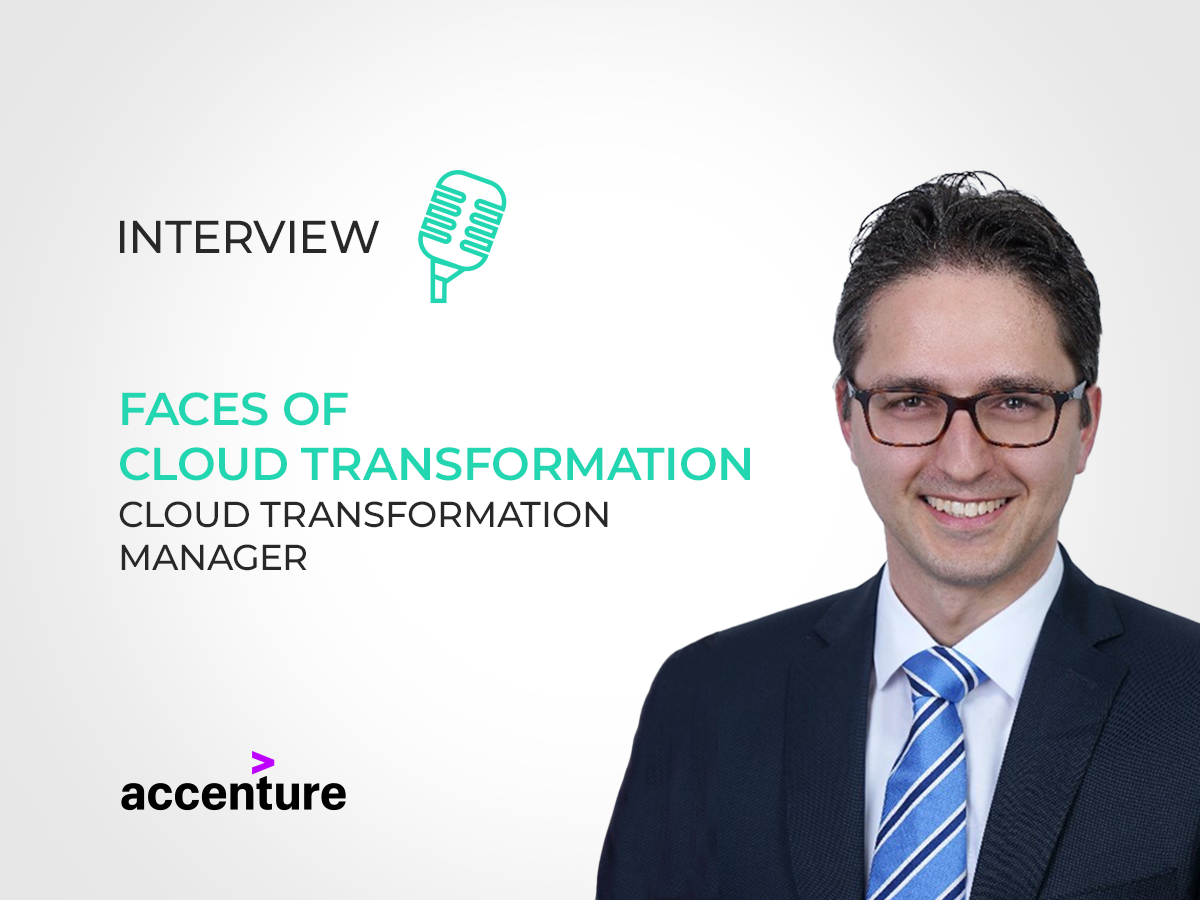Faces of Cloud Transformation

We had the honor to interview Tobias Abt, Lead Cloud and Infrastructure Switzerland at Accenture.
Read about his role, tasks, and best practice tips for a smooth cloud transition in our third installment of our "Faces of Cloud Transformation Interview Series".
What is your role, and how do you see the topic of cloud transformation?
I’m a cloud transformation expert, helping enterprises in Switzerland on their end-to-end cloud transformation journey - from strategy to execution. While shaping cloud transformations for my clients, I take a clear business value focus, i.e., how can cloud and IT support the business better – by delivering new features faster, enabling new innovative business services, or even supporting entirely new business models. Important in that context is that cloud is not purely a technical endeavor, it requires a holistic end-to-end approach, taking into consideration the operating model, people, and service consumption beyond the technology architecture. At Accenture, I’m the lead of our cloud and infrastructure team in Switzerland. Together with our Swiss clients, we migrate and transform their IT landscape in the cloud, enabling them to leverage new, innovative services with a broad 360-degree view across multiple industries. As part of our engagements, we cover the following dimensions – from assessment and strategy into operations:
- Architecture: covering technical questions like: How will my future integration layer look like? What container technology do I want to use? What hyperscalers fit my needs the best and how do I manage my multi-cloud setup? How do I ensure security?
- Organization: addressing the capabilities from an organizational perspective: What processes, skills and structures need to be established? How does the governance need to be adopted and what guardrails need to be put in place to fully leverage the benefits?
- Enablement & Change Management: looking at what skills the people already have, what skills will be needed and what development paths can be foreseen? Also, how do you internally communicate the transformation, so every employee is onboard and convinced and has a clear perspective on his future role?
- Service Design & Build: addressing the need to allow IT-, business- and customers to consume cloud services in a simple, compliant, and integrated manner: What services will be offered? How will they be offered? And how will they be consumed and charged back to the consumer?
Has there been a recent shift in the tasks, responsibilities, and role of a cloud transformation manager?
I would say that there has not been a significant shift in my role, besides a shift in terms of the client moving away from doing pure lift and shift migrations. Many clients actually want to accelerate their journey to the cloud with a mixed lift & shift and modernization approach. In my role, I help them to move fully into the public cloud, end-to-end. There will be some degree of transformation and modernization over the next few years for sure. That’s the major shift that I see.
What are the success factors for an efficient cloud transformation?
Firstly, it's fundamental to have clear business objectives and business-cases in mind before a transformation. As mentioned earlier, the cloud is not a technical evolution, but a fundamental change in how we consume and manage technology. This requires setting clear targets on what needs to be achieved and what boundary constraints are to be met.
Second, it’s important to have transparency over the current landscape – including the relevant aspects around hardware, applications, people, skills, and processes. When shaping a value-based cloud transformation the starting point and baseline is important to be able to take the right decision on the future technology stacks, future application hosting, and the new way of working in IT and business organizations with cloud.
Third, the value of a cloud transformation is not only to be assessed upfront but throughout the transformation. This requires, next to a substantiated roadmap, an objective key result (OKR)-based measurement mechanism to track and quantify the value realized. Those value measures should also be adopted over time as circumstances change. Lastly, transformation is all about people. Technology alone cannot achieve the desired value, nor can the best operating model and governance by itself. Not putting people at the center of the transformation from day-1 is often seen as a mistake, leading to either a slower pace of transformation, higher complexity, or even fierce resistance to adapting to the new environment. It’s important for each role to see how they can contribute to the whole and how their role now may develop and change over time.
What are the biggest hurdles or difficulties?
The need for communication and continuous coaching and enablement is key.
People need to understand:
- WHY: Why are we moving to the cloud? (The problem statement)
- WHAT: What will the future look like in private and/or public cloud? (The scope to be transformed)
- HOW: How are we transforming? (The roadmap)
A key question to be addressed is also “What’s in it for me?” How does everyone’s future role look like and why is it “cooler” to work in the cloud? Another typical challenge is to set the right priorities and determine the appropriate pace of change for the organization. Transforming too many things in parallel often leads to frustration and mental overload. Setting intermediate goals, following an agile-based transformation approach, and having people commit to their own objectives are key.
Are there ways to make your job easier?
What has tremendously improved over the last 2-3 years is the tooling capabilities. It’s important to have transparency over the IT estate throughout the transformation. An integrated toolchain allows to reduce manual work, collect data about the as-is estate, and stay on top of the complexity of such a transformation by planning and tracking the transformation until the end. There is a plethora of tools available on the market, – hyperscaler migration tools as well as discovery, assessment, and planning third party tools. Those tools have become significantly better and easier to use, and they support a wider spectrum of technologies. Key in this discussion is the integration of those tools to have an integrated toolchain from discovery to cutover to avoid breaks in the data flow and inconsistencies among the data sources used. At Accenture, we have an integrated toolchain named MyNav that is being used in end-to-end cloud transformation, covering all relevant aspects. As part of this MyNav toolset, Txture helps to assess the whole application landscape, evaluate possible business cases and recommend migration strategies to help you succeed with your cloud transformation project.
Do you have any best practices or expert advice for enterprise architects at other companies?
Adding to the success factors, I’d like to highlight how important it is to make the cloud transformation an enterprise transformation, not just an IT transformation. Business and IT need to work together from the beginning onward in order to achieve the desired outcome and create value for the company. A second aspect is to follow a holistic approach. The transformation does not end with migrating a workload like-for-like into the cloud, but application modernization and modern DevOps processes and tools will also need to be considered. Having a solid foundation is also instrumental. All the tools, processes, and trainings need to be tested, and typically a proof of concept (PoC) is run before the transformation is scaled. To sum this up, having a holistic approach with IT and business shaping and executing the transformation jointly, backed by an integrated toolchain, are the key ingredients for success.
Expert tip:
Having a holistic and joint IT and business cloud transformation approach, a strict value-oriented governance and an integrated toolchain are key ingredients for success.
Request a free personal demo session and see the tool in action >>
Related posts
14.11.2023Cloud MigrationSecurity risks of cloud computing11.5.2023
Modernization StrategyModernizing legacy IT applications30.3.2023
Cloud Migration Cloud Migration Overview | The 4 Phases & Best Practices6.12.2022
Cloud Target ArchitectureCloud Transformation: how to define the right cloud solution architecture16.11.2022
Cloud AssessmentReady, set, cloud: What is a cloud readiness assessment?
